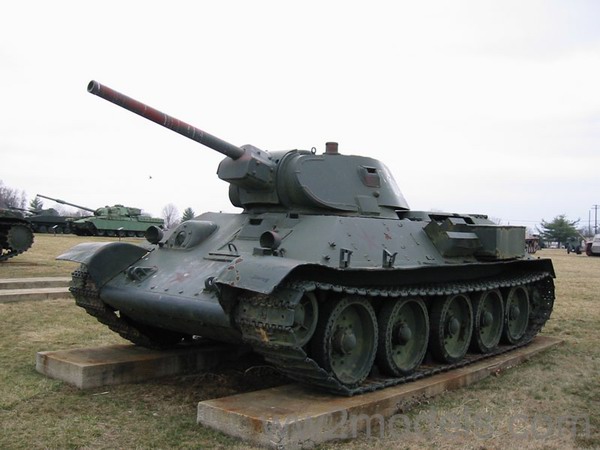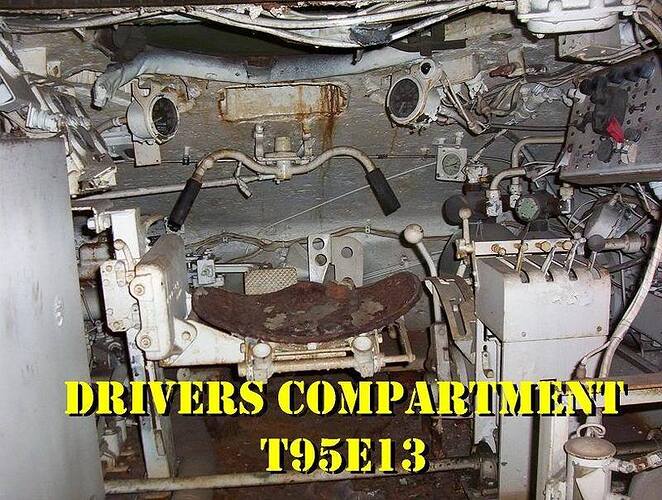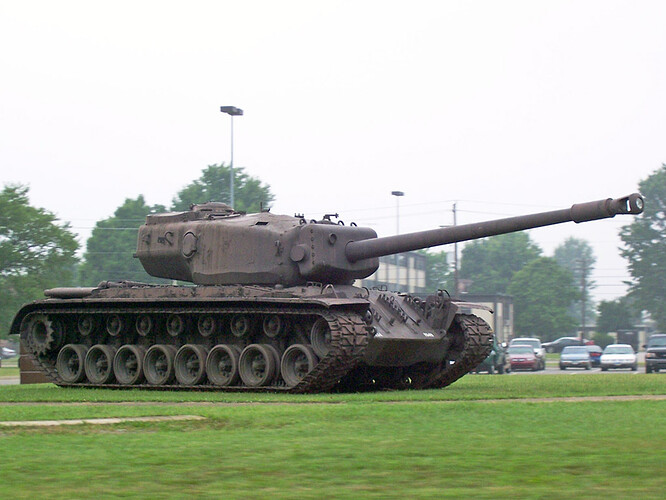Sometimes called the T-95,at others the T-29, I have not had my hands on this one, it’s part of the old Patton Museum Stable, now located at the new Facility on Ft. Benning, Ga. It’s truly huge, about 65 tons, and had a 105mm main gun, and 4 Machine guns. If I read correctly, two 50BMG’s coaxially mounted, one 50BMG independantly mounted, and a .30 cal in the bow position. It had a 6 man crew, with two loaders. Perhaps it was originally intended to counter the German Tigers I, and II, but could have done well against the soviet IS models as well. This was a trials only project, and several others were also looked at, but none were ever built for use. I don’t know much at all about it, but do have some images. Courtesy of Museum personnel.
I don’t think the T-29 was called the T-95, pretty sure that T-95 was the alternate name for the T-28 MGC.
Could be, but that’s what the Museum people call it, Correct on the T-28/95. I’m thinking the Military got their T’s confused after awhile. Since these were all Trials vehicles, I was thinking re-use of T-designations might be the reason, but on line sources agree with you. They also were sloppy in using the dash in some nomenclature, T28 Vs. T-28 This may also add to confusion.
At any rate, getting an inside shot of one of these doesn’t happen that often, so I went with it .
Ah, that’s probably the case.
Agreed, the interior is pretty worth it. Doesn’t look comfortable.
No argument there, they could have spent $3 for a seat cushion, and worse still, there’s no bell on the handlebars…
I think there were a whole series of these vehicles and possibly dozens were produced as test mules. There was also a T-30 & T-34 and possibly others. They paves the way for the Pershing/Patton tanks that followed on. I think they were never seriously considered for deployment to combat unless of course the continental U.S. was invaded…
Who could be that idiot , wanted to invide the US? 
Wanted and being able too are two different things. 
The Germans and Japanese had a tentative plan to split the United States in half (roughly) at the Mississippi River…
The heavy Tank programs were mostly just research, or proof of concept experiments. None were ever moved to any sort of production status beyond the one or two prototypes. Normally, these vehicles would be scrapped to deny anything of use to the espionage folks. not altogether the materials, or mechanical technology, but even to learn about how the U.S. or NATO thinks when developing equipment. For whatever reason these were given to Aberdeen Proving grounds, or some other such facility, to keep. The purpose of this particular vehicle was to counter German heavy / super heavy armor should it come to be made, and used. Also, to counter Soviet heavies, and whatever they might come up with later on. (You are a very clever People Chevan, so we had to keep an eye on you all. )  Once the MBT vehicles were provided with munitions such as Rigid Composite (arrowhead) Sabot, and Heat, it didn’t much matter how much armor, or even how large the gun was, these two staple munitions made the old ways obsolete. The Range finder on the T-29 was interesting, and made its Turret looks more as though it had been lifted off a Warship, and plopped on the Tank Hull. But the range finder was an important step forward in fire control.
Once the MBT vehicles were provided with munitions such as Rigid Composite (arrowhead) Sabot, and Heat, it didn’t much matter how much armor, or even how large the gun was, these two staple munitions made the old ways obsolete. The Range finder on the T-29 was interesting, and made its Turret looks more as though it had been lifted off a Warship, and plopped on the Tank Hull. But the range finder was an important step forward in fire control.
The “T” designation for a U.S. Tank is used only during development, the “M” given after it is adopted as a final design and approved for production. I didn’t want you to be confused by that Chevan since sometimes the numbers used are the same as those of Soviet military. (like the T-34) Pics of our T-34, and Soviet T-34

Well, you’re showing a base T-34, they did have the 85 and 100 models. Though I’m sure the 120 on the American '34 would make mincemeat of any Russian '34.
I think there were more than few made, just the different configurations alone would indicate at least a dozen heavy tank prototypes. I think some were even used at War Bond events…
The T-29, T-30, T-32, and T-34 were variations on a theme, using different sized guns, and other changes in automotive, and perhaps metallurgy to see what might result. These projects were begun because while the M-26 was a stout, and well armed vehicle, it was thought to be less than dependable against the late German Tiger II, as well as whatever else Germany might come up with should the War have continued for another season or so. While some of these projects did bear fruit enough to rate a limited number of vehicles to be built “just in case” none of them went very far. Some of these did contribute to the development of the M-103 program.
Post War, it was eventually decided that Heavy Tanks were not the best use of resources on a large scale, so the MBT developed as we have seen, till technology allowed the likes of Challenger, the Abrams, Merkava etc. to be built, and operated successfully. (at least until someone develops something even newer to send them to the recycle bin. ) The never ending game of Measure - Counter measure.
The Soviet T-34 despite the later, better models was still a medium vehicle, I was only showing the possibility of mistaking one vehicle for another because of Nomenclature issues. Like the two items the military had that used the same nomenclature, the P-38. One was a can opener, the other an Aircraft. (Not to leave out the German pistol of the same name. ) Nomenclature, the modern Latin. 
A tentative plan? But the Germans never had enough ships to invide even the Britain, an japs never sailed further the Australia;)
But the Germans never had enough ships to invide even the Britain, an japs never sailed further the Australia;)
All of the post-ww2 soviet mass produced tanks were medium - no more then 40 tonns weightn. As i know, according our standards even the Abrams is “heavy” tanks
he T-29, T-30, T-32, and T-34 were variations on a theme, using different sized guns, and other changes in automotive, and perhaps metallurgy to see what might result. These projects were begun because while the M-26 was a stout, and well armed vehicle, it was thought to be less than dependable against the late German Tiger II, as well as whatever else Germany might come up with should the War have continued for another season or so.
But Pershing was more then match agains Tigers, and it definitelly was more powerfull then the Panther.
if we are clever- why are we telorate the Putin then? It’s very complicated…
It’s very complicated…
The “T” designation for a U.S. Tank is used only during development, the “M” given after it is adopted as a final design and approved for production. I didn’t want you to be confused by that Chevan since sometimes the numbers used are the same as those of Soviet military. (like the T-34) Pics of our T-34, and Soviet T-34
There is no confuse mate;) The tank above was called the M-29. That is fully logically ,as it folows after the M-26
Of course it was a fantasy, based on the conquest of the USSR, capitulation of Britain and a whole host of unlikely events. I was just saying the only way these designs would see combat was if the war came to them…
It seems the M103 suffered from a lot of teething problems and simply wasn’t as efficient as medium, or main battle, tanks. Especially after the 105mm gun came online. But I’d like to know you’re opinion of them or if you served with any former crewmen…
Post War, it was eventually decided that Heavy Tanks were not the best use of resources on a large scale, so the MBT developed as we have seen, till technology allowed the likes of Challenger, the Abrams, Merkava etc. to be built, and operated successfully. (at least until someone develops something even newer to send them to the recycle bin. ) The never ending game of Measure - Counter measure.
I believe the U.S., Soviets, and British all came to that conclusion around the same time. The IS8 was probably the only heavy tank that saw combat (by Egyptian forces against Israel), but while it had some short lived initial success because of the thick armor, they eventually overheated or taxed their drive-trains and were easily outflanked. The World of Tanks game is the only place where the post war heavies seem to do well… 
I have watched videos by the Mighty Jingles, and agree that the Heavy/super heavies do well only when physics do not apply. 
none I know personally was crew for a 103, it would have made for some good stories over a beer or two. I would have loved to get aboard one, even crew one for awhile, but they were out of service with the Army by then. I did see a couple as displays at Ft. Knox, very impressive up close. As you say Nick, once the L-7 gun showed up with its modern munitions, the need for heavy Tanks evaporated, and they became dinosaurs fit only for looking at. It did always seem to come down to drive line issues with the big ones, no one ever figured out how to keep them moving. These days the Turbine does the job, and whatever they use for a transmission, but even the turbine may disappear now that a good Diesel is available for the Abrams don’t recall details, but it sounded good from the article I read. This would be a huge help to the Abrams, and increase its time between refills tremendously.
It just occurred to me that it would be unlikely you met any 103 crew, because I think only a few dozen were in service at any time. The Marines actually operated a lot more of them (200?). What they were to do with a heavy tank with no range I have no idea…



